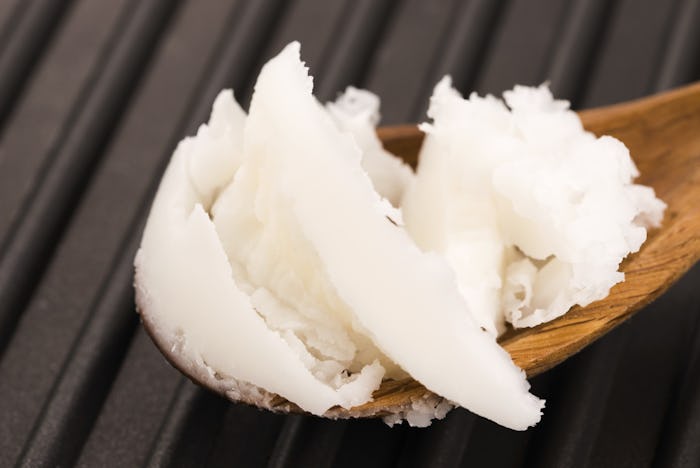Life

Rejoice! You Can Use Coconut Oil For Thrush, & Here's How.
I don't mean to be hyperbolic, but coconut oil is magic. Whenever you have a problem it seems there's a coconut oil fix for it. I've heard stories of coconut oil wondrously making warts fall off, fixing cradle cap, and removing crayon from walls. I'm telling you, magic. So, of course, there are probably hundreds of ways you can use coconut oil when you have a baby, but how do you use coconut oil for thrush?
One simple way to use coconut oil for thrush is to put it on your nipples before breastfeeding to prevent passing the yeast infection back and forth between you and your baby. BellyBelly also cites virgin coconut oil as a great treatment for thrush, reporting that virgin coconut oil is "a very powerful anti-funga." However, it's important that you speak to your health care provider if you believe you and/or your baby have thrush, because he or she will likely want you to use another form of treatment in addition to coconut oil, as coconut oil on its own may not eradicate the infection fully.
Let's break down the basics, starting with what thrush is and how you might know you have it. For the most part, the right amount of the candida fungus lives in your mouth, on your skin and in your digestive tract, but certain circumstances can change the equilibrium of candida which can lead to an infection. WebMd reports, "Certain illnesses or medications, like corticosteroids or antibiotics, can disturb the balance." Stress and medical conditions, such as HIV, uncontrolled diabetes, cancer, and dry mouth can also cause someone to develop thrush.
WebMd explains that thrush is "an infection caused by the candida fungus, which is yeast. You can get it in your mouth and other parts of the body. It can cause diaper rash in infants or vaginal yeast infections in women." Thrush can also cause an oral infection in infants that can pass between mom and baby in an infinite loop if it's not treated properly.
The aforementioned infinite loop can be a real pain for both baby and mom, according to La Leche League, the authority on all things breastfeeding. Thrush can causing irritability in the baby, as well as a white spots on their tongue and cheeks, diaper rash, discomfort when nursing, and cracking around their mouth.
Mom's symptoms can include "prolonged or sudden onset of sore nipples during or after the newborn period (the nipples may be pink, flaky, crusty, and itchy, or red and burning), cracked nipples, or a vaginal yeast (monilial) infection," according to La Leche League. Oh, but that's not all. La Leche League explains further, reporting, "An intense stabbing or burning pain in one or both breasts during or shortly after feedings may mean that a secondary yeast infection has developed within the milk ducts." Ouch.
If you find yourself experiencing the pains of thrush, know that doctors typically prescribe Nystatin suspension for the baby and breastfeeding mother to take for up to two weeks. In addition, coconut oil can be a good complement to the medication, according to Breastfeeding-problems.com, which reports that, "You can put pure, raw, virgin coconut oil on your nipples and inside your baby's mouth to prevent passing the infection to one another."
Prevention of thrush is obviously important, but a little tricky. BabyCenter suggests refraining from giving your baby antibiotics unless absolutely necessary, since they can cause candida to get out of whack. Additionally, "Cleaning and sterilizing pacifiers also may help. And some providers advise breastfeeding mothers to let their nipples air dry between feedings to help prevent thrush." And if you do contract thrush make sure you take all prescribed medication (and maybe a little coconut oil) in order to keep it from passing between mom and baby. As always, it's best you consult with your health care provider immediately.
Check out Romper's new video series, Romper's Doula Diaries:
Watch full episodes of Romper's Doula Diaries on Facebook Watch.